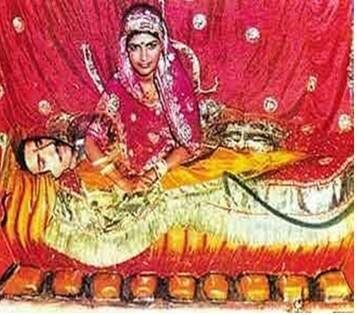Table of Contents
Sati Definition
Sati means the voluntary or forced burning or burying alive of a widow. In Sanskrit the word sati is derived from “SAT”.
History
This was a dharmic paratha in Hindu dharma in this dharma when husband dies during his Antim sanskar his wife also gets burned in the Agni and she dies along with his husband. This procedure is also called Athma dah.
The name of this paratha was given from the daughter of Daksh whose name was sati and also called Adi shakti. sati has sacrificed her life as his father Daksh humiliated shiv.
Sati karma means when a person is dead his clothes, shoes, gold and his wife should be burnt & sometimes they also burry dog, horse, servant etc with the dead body.
Today also in different states like Madhya Pradesh, Rajasthan, Haryana there is sati ka choura, sati Gate, sati Mohalla are there.
Sometimes it happens that men are killed for a fake reason and their wives are made maid by other people.
Just to fulfil the needs of sati a shloka in Atharvaveda is written that women lay down in the Chita of husband and other people around her asks her to get up and live the entire life with his son & daughter, by doing this step they think that sati is committed, and the women is also saved.
Sati Prevention Act, 1987
Whoever does any act for the glorification of sati shall be punishable with imprisonment for a term which shall not be less than one year, but which may extend to seven years and with fine which shall not be less than five thousand rupees, but which may extend to thirty thousand rupees.
It took a long time to stop sati paratha and make it a law it was stood void in 1829 and it encouraged in law by 1987 as sati (Prevention) Act.
It became an Act of the Parliament of India with the enactment of The Commission of Sati (Prevention) Act, 1987 in 1988.
In 1829, After Raja Ram Mohan Rai a person named Lord William Bentick said that sati paratha was a void act done by the people which is also a shameful for our society.
This Act provides benefits to women as sati was a wrong Pratha for women and society so it must be changed and must save the life & rights of women.
Some Essential points regarding the sati prevention Act 1978: –
“Special Court” means a Special Court constituted under section 9.
Clause (3) Attempt to commit sati— whoever attempts to commit sati and does any act towards such commission shall be punishable with imprisonment for a term which may extend to six months or with fine or with both.
Clause (4) Abetment of sati—if any person commits sati, whoever abets the commission of such sati, either directly or indirectly, shall be punishable with death or imprisonment for life and shall also be liable to fine.
Clause (5) Punishment for glorification of sati—Whoever does any act for the glorification of sati shall be punishable with imprisonment for a term which shall not be less than one year but which may extend to seven years and with fine which shall not be less than five thousand rupees, but which may extend to thirty thousand rupees.
Case Laws
The last case of sati has taken place in Rajasthan (Divrala Gao)
In this case Roop Kanwar was one girl who was immolated along with her husband’s dead body. The girl was just 18-year-old and was burnt alive. She was then considered sati Mata.
There is no further information given regarding this case.
Conclusion
As above information sati is accurately described by me. As per my point of view sati Pratha was a wrongdoing act in older times. Now there is no religious activity in our society, so it is a good step for growth of women in today’s generation. Sati is totally eradicated from our society, so it shows that people are more feminist. In earlier times when the husband is dead the life of women also stops, she does not get another chance to live but now the things have changed and to continue the life of women, they can marry another person.
Author: Shashank Tripathi,
Navrachana University 2nd year/ Student

